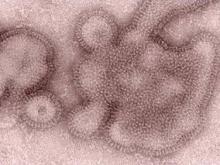SAN FRANCISCO – The H3N2 virus could sicken 500-900 people in the United States by the end of 2012, surveillance studies by the Centers for Disease Control and Prevention suggest.
"Cooler weather is approaching, and it is likely that additional cases of H3N2v will be identified in the coming weeks," said Lyn Finelli, Dr.PH., chief of surveillance and outbreak response in the influenza division at the CDC’s National Center for Immunization and Respiratory Diseases, Atlanta.
Between December 2005 and June of 2012, there have been 36 human cases of swine influenza A virus infection identified, Dr. Finelli said at the annual Interscience Conference on Antimicrobial Agents and Chemotherapy. "Identification has increased since 2009" as novel influenza A became a reportable disease in 2007, better diagnostics became available at state health departments, and there has been greater awareness due to the 2009 pandemic H1N1 virus.
In 2011, public health officials in the United States identified 12 cases of H3N2v with the pandemic M gene from the 2009 pandemic H1N1 virus. Six were associated with exposure at agricultural fairs or farms and six were cases of human to human transmission.
This subtype continues to spike in prevalence. Between July 1 and Sept. 10, 2012, 302 cases of H3N2v infection with the M gene have been confirmed in the United States. The M gene "was thought to contribute to increased transmissibility of the pandemic H1N1 virus," Dr. Finelli noted. "In two animal studies it was shown to increase transmissibility for pandemic H1N1 ... Various serologic studies to date suggest that children under 12 have very little protection against this virus."
An outbreak of H3N2v is occurring in 10 states, and 16 patients have been hospitalized. Indiana has the most confirmed cases, followed by Ohio and Wisconsin. "Ohio also has a large number of probable cases, many of whom are rapid test positive but who have not been tested with PCR, so that state probably has more cases than Indiana at this point," Dr. Finelli said.
The mean age of the 302 cases is 8 years, with a range between 4 months and 74 years, and the incubation period is 2-3 days. "The secondary attack rate is low," she said. "We only have 10 probable cases of human to human transmission. The duration of illness is 3-4 days and the period of infectiousness is unknown. We don’t have enough secondary transmission to tell."
Of the 16 patients who have been hospitalized with H3N2v, 14 (87%) were 0-17 years of age and the remaining 2 were at least 18 years of age. The most common underlying condition is being 5 years of age or younger (38%), followed by asthma (19%), cancer or immune suppression (19%), and neurological disorder (13%). One patient died (7%).
Dr. Finelli and her associates have exposure data on 203 cases. Of these, 198 (98%) had either direct or indirect swine contact, or attended a state or county fair.
Antiviral treatment with oral oseltamivir or inhaled zanamivir is encouraged as soon as possible for patients with suspected H3N2v virus infection, especially hospitalized patients or patients with severe or progressive illness, she said. "All non–high-risk outpatients without underlying medical conditions can be started within 48 hours of illness onset."
"Surveillance guidance for state and local public health has focused on increasing collection of PCR quality specimens from patients presenting with influenza-like illness in high risk groups, such as outbreaks in child care and school settings or in populations where confirmed H3N2v cases have occurred," Dr. Finelli said.
Two candidate H3N2v vaccines have been identified and have been sent to the World Health Organization, the Food and Drug Administration, and vaccine manufacturers, she said. Clinical trials using the National Institutes of Health’s Vaccine and Therapeutics Evaluation Unit are now under way.
The conference was sponsored by the American Society for Microbiology. Dr. Finelli said that she had no relevant financial disclosures to make.



